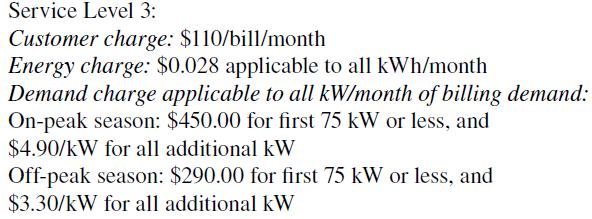A company is on the utility rate structure defined as level 1 in Problem 2.5 , In
Question:
A company is on the utility rate structure defined as level 1 in Problem 2.5 , In auditing a company, you find it averaged as 65 percent power factor over the past year. It is on the rate schedule given in the class handout and averaged 1,000 kW/month. Neglecting any ratchet clause and assuming the demand and power factor is constant each month, calculate the savings for correcting to an 80 percent power factor. How much capacitance would be necessary to obtain this correction? Assume level 1.
Problem 2.5
A utility offers the following rates to its commercial customers:

The on-peak season includes the months of June through October. The off-season includes the remainder of the months of any year.
The billing demand is defined as the maximum demand as determined above, corrected for the power factor (refer to the power factor clause defined below), provided that no billing demand shall be considered as less than a percentage of the highest on-peak season maximum demand corrected for the power factor previously determined during the 12 months ending with the current month.
The following power factor clause applies to all the utility rate structures.
Power factor clause: The consumer shall at all times use power so that the power factor shall be as close to 100 percent as possible, but when the average power factor as determined by continuous measurement of lagging reactive kilovolt-ampere hours is less than 80 percent, the billing demand shall be determined by multiplying the maximum demand, shown by the demand meter for the billing period, by 80 and dividing the product thus obtained by the actual average power factor expressed in percent.
i. A large manufacturing company is on the level 3 rate schedule. Its peak demand for the previous year is shown below. It found a way to reduce demand in the off-peak season by 100 kW, but the peak season demand will be the same (i.e., the demand in each month of November through May would be reduced by 100 kW). Assuming the company is on the 65 percent ratchet clause specified in the rate schedule, what is the dollar savings? Assume the high month was July of the previous year at 1,150 kW. If the demand reduction of 100 kW occurred in the peak season, what would be the dollar savings (i.e., the demand in June through October would be reduced by 100 kW).
ii. Determine among the three available rate structures the rate level that minimizes the annual utility bill for the manufacturing company before any demand reduction.
Step by Step Answer:

Energy Audit Of Building Systems An Engineering Approach
ISBN: 9780367820466
3rd Edition
Authors: Moncef Krarti





